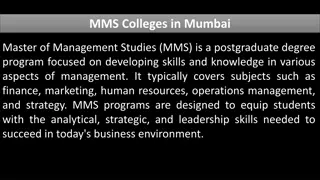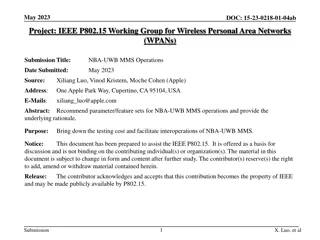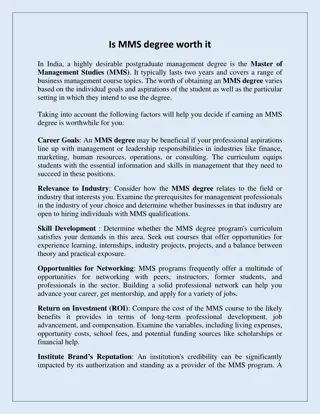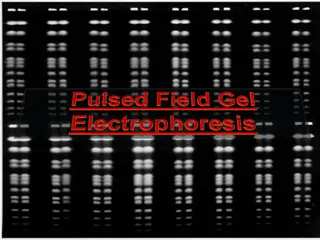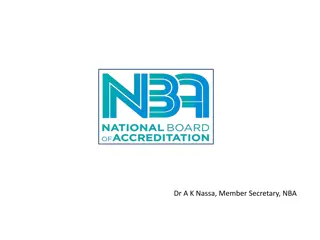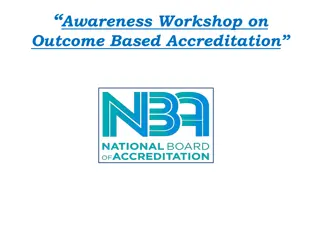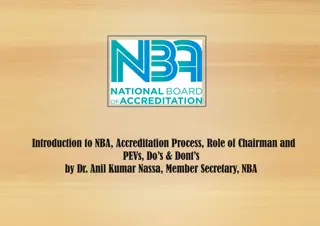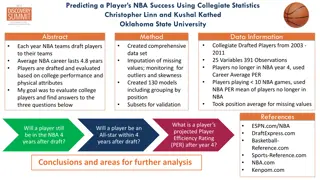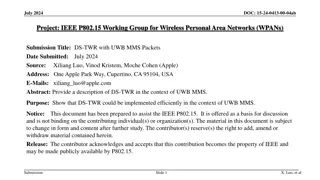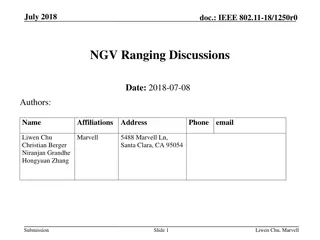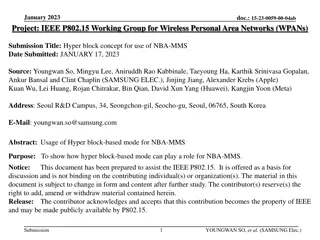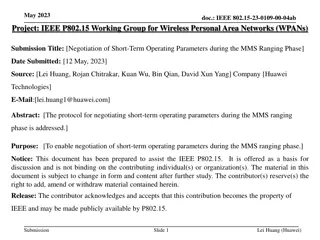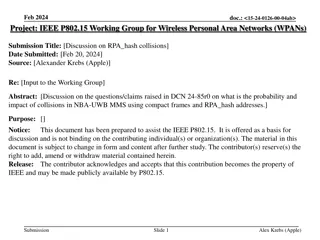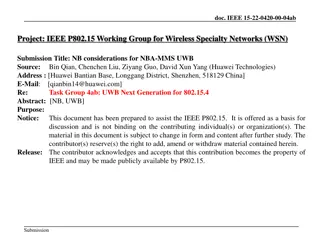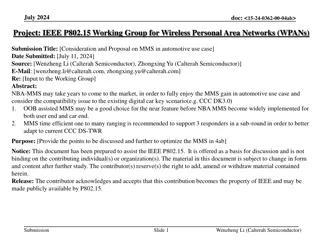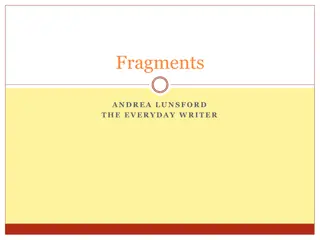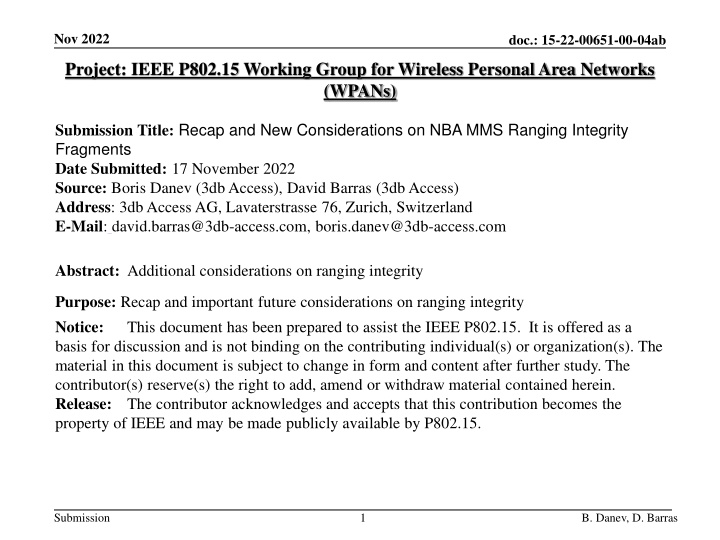
New Considerations on Wireless Personal Area Networks Ranging Integrity
Delve into the important aspects of ranging integrity in wireless personal area networks (WPANs), exploring current challenges and future considerations to enhance accuracy, reliability, and interoperability. The document discusses safeguarding high throughput data usage without disrupting low duty-cycle ranging, interference mitigation techniques, coexistence improvements, regulatory changes, link budget enhancements, and operational solutions for improved performance and efficiency.
Download Presentation

Please find below an Image/Link to download the presentation.
The content on the website is provided AS IS for your information and personal use only. It may not be sold, licensed, or shared on other websites without obtaining consent from the author. If you encounter any issues during the download, it is possible that the publisher has removed the file from their server.
You are allowed to download the files provided on this website for personal or commercial use, subject to the condition that they are used lawfully. All files are the property of their respective owners.
The content on the website is provided AS IS for your information and personal use only. It may not be sold, licensed, or shared on other websites without obtaining consent from the author.
E N D
Presentation Transcript
Nov 2022 doc.: 15-22-00651-00-04ab Project: IEEE P802.15 Working Group for Wireless Personal Area Networks (WPANs) Submission Title:Recap and New Considerations on NBA MMS Ranging Integrity Fragments Date Submitted: 17 November 2022 Source: Boris Danev (3db Access), David Barras (3db Access) Address: 3db Access AG, Lavaterstrasse 76, Zurich, Switzerland E-Mail: david.barras@3db-access.com, boris.danev@3db-access.com Abstract: Additional considerations on ranging integrity Purpose: Recap and important future considerations on ranging integrity Notice: This document has been prepared to assist the IEEE P802.15. It is offered as a basis for discussion and is not binding on the contributing individual(s) or organization(s). The material in this document is subject to change in form and content after further study. The contributor(s) reserve(s) the right to add, amend or withdraw material contained herein. Release: The contributor acknowledges and accepts that this contribution becomes the property of IEEE and may be made publicly available by P802.15. Submission 1 B. Danev, D. Barras
Nov 2022 doc.: 15-22-0651-00-04ab Recap and New Considerations on NBA MMS Ranging Integrity Fragments Submission 2 B. Danev, D. Barras
Nov 2022 doc.: 15-22-0651-00-04ab PAR Objective Safeguards so that the high throughput data use cases will not cause significant disruption to low duty-cycle ranging use cases Interference mitigation techniques to support higher density and higher traffic use cases Other coexistence improvement Backward compatibility with enhanced ranging capable devices (ERDEVs) Improved link budget and/or reduced air-time Proposed Solution (how addressed) NBA-MMS and new regulatory changes in EU to improve link budget Additional channels and operating frequencies Improvements to accuracy / precision / reliability and interoperability for high-integrity ranging Reduced complexity and power consumption Quantifiable integrity levels that are not channel-dependent to allow interoperability distance commitment approach on challenge/response messages, real time and reduced post-processing Exploit tightly coupled concurrent operation of NB for secure ranging Hybrid operation with narrowband signaling to assist UWB Enhanced native discovery and connection setup mechanisms Sensing capabilities to support presence detection and environment mapping Low-power low-latency streaming Higher data-rate streaming allowing at least 50 Mbit/s of throughput Support for peer-to-peer, peer-to-multi-peer, and station-to- infrastructure protocols Infrastructure synchronization mechanisms Submission 2 B. Danev, D. Barras
Nov 2022 doc.: 15-22-0651-00-04ab References [0571] 15-22-0571-00-04ab-nba-uwb-technical-framework-proposal-2022-nov [0074] 15-22-0074-00-04ab-link-budget-analysis-for-nba-mms [0076] 15-22-0076-00-04ab-extending-nbuwb-for-secure-ranging [0392] 15-22-0392-00-04ab-more-on-mixed-mms-for-ranging-integrity [0413] 15-22-0413-00-04ab-performance-analysis-of-ranging-integrity-fragment-with- distance-commitment [18-22-0141] 802.18/dcn/22/18-22-0141-00-0000-new-uwb-regulation-in-europe.pptx Submission 4 B. Danev, D. Barras
Nov 2022 doc.: 15-22-0651-00-04ab RIF format for Ranging Integrity Ranging Integrity for the updated NBA-MMS framework 4ab [0571] RIF message for ranging integrity based on distance commitment RIF is built from bursts which each carry 1-bit of cryptographic information Submission Slide 5 B. Danev, D. Barras
Nov 2022 doc.: 15-22-0651-00-04ab Hardness Assumption for Ranging Integrity Hardness assumption in integrity ranging = bring the integrity of the measured distance to the probability of guessing cryptographic bits E.g., If one decodes 20 bits (burst) the probability of guessing the cryptographic bits carried by the RIF bursts is 2-20( 1/1 000 000) 1 0 1 0 0 1 1 Submission Slide 6 B. Danev, D. Barras
Nov 2022 doc.: 15-22-0651-00-04ab Distance Commitment & Hardness Assumption Distance commitment consists in verifying the hardness assumption at the Time-of-Arrival (ToA) of the RIF bursts ToA ToA ToA 0 1 0 0 1 ToA Submission Slide 7 B. Danev, D. Barras
Nov 2022 doc.: 15-22-0651-00-04ab Example of a failing distance decrease on RSF Distance commitment consists in verifying the hardness assumption at the Time-of-Arrival (ToA) of the RIF bursts When attacker advances the ToA during RSF phase, the bursts won t be correctly decoded (attacker can only make guesses with an overall success of 2-20) ToA ToA ToA 0 1 0 0 1 ToA Submission Slide 8 B. Danev, D. Barras
Nov 2022 doc.: 15-22-0651-00-04ab Practical implementation of RIF verification How distance commitment works in NBA-MMS ? Sending only 20 bursts ( = verifying 20 bits with no errors) Require high peak power (regulation issues) Requires high SNR at the receiver In NBA MMS we send more bits (1024) and tolerate a defined number of errors (435) for same 20 bits of security Submission Slide 9 B. Danev, D. Barras
Nov 2022 doc.: 15-22-0651-00-04ab Advantages of RIF with distance commitment NBA MMS RIF with distance commitment enables quantifiable ranging integrity Interoperability b/w vendors Open and well-defined method Formally proven in literature White-box security certification Submission Slide 10 B. Danev, D. Barras
Nov 2022 doc.: 15-22-0651-00-04ab Current limitations and future expectations Current limitations: Latency in MMS integrity ranging is becoming critical in some applications (access control & localization+access control, wall effect) Recent updates on EU regulations ([18-22-0141] generic indoor) will solve this issue by enabling 8 MMRS within one millisecond and 8 RIFs within the next millisecond Only possible in indoor access (not for car access) -31.3 dBm / MHz, Can we further combine RSF and RIF in order to reduce latency of NBA MMS integrity ranging with similar link budget and integrity level? 1ms (Y-2) ms RSF/RIF 1 RSF/RIF 2 RSF/RIF Y NB NB NB UWB UWB Submission Slide 11 B. Danev, D. Barras

